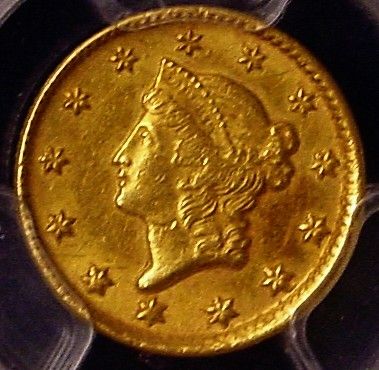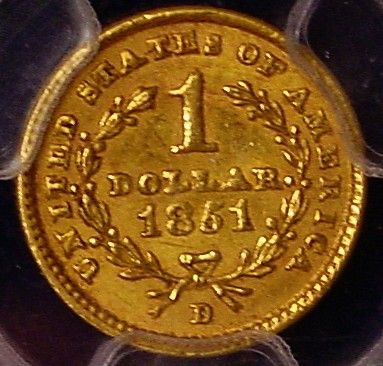For those who like crusty gold, an 1851-D Gold Dollar
I have been working on a set of the Type I gold dollars by date and mint for a couple of years. I have just over half of them, and I have been trying add at least one piece at each regional or national show I attend. It's not been easy, and it will only get harder, but I did found this and one other piece at the Baltimore show. The complete collectable set has 24 coins in it.
Here is an 1851-D gold dollar in PCGS AU-55. The big attraction here is that the coin has original surfaces. Finding pieces that have not been fooled with is getting harder and harder. I would much rather have one original surface AU than a scrubbed up "Mint State" piece with funky color that is caused by cleaning.
This piece as a few more marks than I would have liked, and according to Doug Winter this is the second most common Dahlonega after the 1849-D. Perhaps I might have waited, but the price was fair for what it is. When it comes to Dahlonega gold, especially with original surfaces, the word "common" is a very relative term.


Here is an 1851-D gold dollar in PCGS AU-55. The big attraction here is that the coin has original surfaces. Finding pieces that have not been fooled with is getting harder and harder. I would much rather have one original surface AU than a scrubbed up "Mint State" piece with funky color that is caused by cleaning.
This piece as a few more marks than I would have liked, and according to Doug Winter this is the second most common Dahlonega after the 1849-D. Perhaps I might have waited, but the price was fair for what it is. When it comes to Dahlonega gold, especially with original surfaces, the word "common" is a very relative term.


Retired dealer and avid collector of U.S. type coins, 19th century presidential campaign medalets and selected medals. In recent years I have been working on a set of British coins - at least one coin from each king or queen who issued pieces that are collectible. I am also collecting at least one coin for each Roman emperor from Julius Caesar to ... ?
1
Comments
I can appreciate the effort, but these $1 golds are just too small for me.
Too many positive BST transactions with too many members to list.
<< <i>
I can appreciate the effort, but these $1 golds are just too small for me. >>
they are small. however, i sometimes imagine how nice a capitol plastic holder with a complete set of type 1's in it would be.
<< <i>Neat project and looks to be obtainable with no stoppers. May be a couple of hard to find "original surfaces stoppers" for your taste, but no skyscraper price dates.
I can appreciate the effort, but these $1 golds are just too small for me. >>
The toughest one, aside from the 1849-C with the open wreath, is supposed to be the 1850-D. I have seen a couple of "visually challenged" examples that had original surfaces, but they looked like well, you know ...
It would also be not that hard to put together a "Mint State" collection - all it takes is money - but, well you know ...
<< <i>
<< <i>
I can appreciate the effort, but these $1 golds are just too small for me. >>
they are small. however, i sometimes imagine how nice a capitol plastic holder with a complete set of type 1's in it would be. >>
I had that idea with early half dimes. I even so far as to have the holder custom made, but Capital Plastics holders are not good for very small coins. They get lost in the thick layer of white plastic, and white is the good color IMO.
<< <i>Why does the field at 4 oclock on the obverse appear dark? >>
That is a copper spot. It is an area where the gold - copper alloy was not well mixed, and the area toned brown just like a copper coin. Cleaning might remove it for a while, but I've seen them return because they are often more than "skin deep."
Many collectors don't like them, but it's part of territory for some U.S. gold coins. One must remember that the Dahlonega mint did not always have the most perfect standards, and the coins often have a "rustic" look about them.
But there is no way to tell that it was never altered with, and all original.
Yes, I agree there sure is a lot of originality in that piece!
Not recent.
Still a very nice piece!
- Jim
The surfaces -
Eric
<< <i>One must remember that the Dahlonega mint did not always have the most perfect standards, and the coins often have a "rustic" look about them. >>
Well said.
"If I say something in the woods and my wife isn't there to hear it.....am I still wrong?"
My Washington Quarter Registry set...in progress
<< <i>That is really nice Bill! The marks you spoke of seem evenly dispersed - not troublesome to me.
The surfaces -
Eric >>
Seems like a lot of people equate copper-toned areas with carbon in them to what I prefer to call "coppery toning". 10 years ago telemarketers were selling "no spots" coins. Toned, carbon, whatever, the untutored masses wouldn't be able to differentiate, and explanations took away from the sales pitch.
I bought and sold the Eliasberg 1834 QE PR64 PCGS in 1988 (IIRC). It was original and had a seriously deep carbon spot on the brow. Last time I saw it, it had undergone professional conservation and was NGC PF64 with all original color gone and the virtually unchanged spot was still there. .
Maybe next time they'll used aqua regia.
Do NOT try this at home, but it ain't that tough. One of the few things I sub-contract out to a chemist who doesn't think he's a coin doctor. .
In passing, I love the OP's coin.
Eric's point about the spacing of the marks creating less distraction is an excellent observation that should be conceptually applied by any grader.
I dunno! I saw what that stuff did to James Mason in the beginning of Journey to the Center of the Earth when they are trying to melt lava!
Thanks for the kind words Col!
Best wishes,
Eric